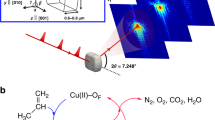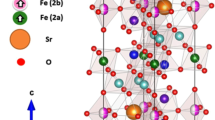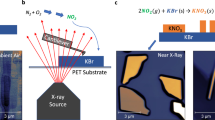Abstract
Zeolites are microporous crystalline materials that find wide application in industry, for example, as catalysts and gas separators, and in our daily life, for example, as adsorbents or as ion exchangers in laundry detergents1. The tetrahedrally coordinated silicon and aluminium atoms in the zeolite unit cell occupy the so-called crystallographic T-sites. Besides their pore size, the occupation of specific T-sites by the aluminium atoms determines the performance of the zeolites2. Despite its importance, the distribution of aluminium over the crystallographic T-sites remains one of the most challenging, unresolved issues in zeolite science. Here, we report how to determine unambiguously and directly the distribution of aluminium in zeolites by means of the X-ray standing wave technique3 using brilliant, focused X-rays from a third-generation synchrotron source. We report in detail the analysis of the aluminium distribution in scolecite, which demonstrates how the aluminium occupancy in zeolites can systematically be determined.
This is a preview of subscription content, access via your institution
Access options
Subscribe to this journal
Receive 12 print issues and online access
$259.00 per year
only $21.58 per issue
Buy this article
- Purchase on Springer Link
- Instant access to full article PDF
Prices may be subject to local taxes which are calculated during checkout



Similar content being viewed by others
References
Maxwell, I. E. & Stork, W. H. J. Hydrocarbon processing with zeolites. Stud. Surf. Sci. Catal. 137, 747–819 (2001).
Baerlocher, C., Meier, W. M. & Olson, D. H. Atlas of Zeolite Framework Types 5th revised edn (Elsevier, Amsterdam, 2001) <http://topaz.ethz.ch/IZA-SC/StdAtlas.htm>.
Cheng, L., Fenter, P., Bedzyk, M. J. & Sturchio, N. C. Fourier-expansion solution of atom distributions in a crystal using x-ray standing waves. Phys. Rev. Lett. 90, 255503 (2003).
Armbruster, T. Clinoptilolite-heulandite: Applications and basic research. Stud. Surf. Sci. Catal. 135, 13–27 (2001).
Dedecek, J., Kaucky, D., Wichterlova, B. & Gonsiorova, O. Co2+ ions as probes of Al distribution in the framework of zeolites. ZSM-5 study. Phys. Chem. Chem. Phys. 4, 5406–5413 (2002).
van Bokhoven, J. A., Koningsberger, D. C., Kunkeler, P., van Bekkum, H. & Kentgens, A. P. M. Stepwise dealumination of zeolite beta at specific T-sites observed with 27Al MAS and 27Al MQ MAS NMR. J. Am. Chem. Soc. 112, 12842–12847 (2000).
Sklenak, S. et al. Aluminum siting in silicon-rich zeolite frameworks: A combined high-resolution 27Al NMR spectroscopy and quantum mechanics/molecular mechanics study of ZSM-5. Angew. Chem. Int. Ed. 46, 7286–7289 (2007).
Kokotailo, G. T., Lawton, S. L., Olson, D. H. & Meier, W. M. Structure of synthetic zeolite ZSM-5. Nature 272, 437–438 (1978).
Treacy, M. M. J. & Newsam, J. M. Two new three-dimensional twelve-ring zeolite frameworks of which zeolite beta is a disordered intergrowth. Nature 332, 249–251 (1988).
Fyfe, C. A., Gobbi, G. C., Klinowski, J., Thomas, J. M. & Ramdas, S. Resolving crystallographically distinct tetrahedral sites in silicalite and ZSM-5 by solid-state NMR. Nature 296, 530–533 (1982).
Henry, P. F., Weller, M. T. & Wilson, C. C. Structural investigation of TS-1: Determination of the true nonrandom titanium framework substitution and silicon vacancy distribution from powder neutron diffraction studies using isotopes. J. Phys. Chem. B. 105, 7452–7458 (2001).
Hijar, C. A. et al. The siting of Ti in TS-1 is non-random. Powder neutron diffraction studies and theoretical calculations of TS-1 and FeS-1. J. Phys. Chem. B 104, 12157–12164 (2000).
Lamberti, C. et al. Ti location in the MFI framework of Ti-silicalite-1: A neutron powder diffraction study. J. Am. Chem. Soc. 123, 2204–2212 (2001).
Marra, G. L., Artioli, G., Fitch, A. N., Milanesio, M. & Lamberti, C. Orthorhombic to monoclinic phase transition in high-Ti-loaded TS-1: An attempt to locate Ti in the MFI framework by low temperature XRD. Microporous Mesoporous Mater. 40, 85 (2000).
Milanesio, M. et al. Iron location in Fe-silicalites by synchrotron radiation single crystal x-ray diffraction. J. Phys. Chem. B 104, 9951–9953 (2000).
Palin, L., C. et al. Single-crystal synchrotron radiation x-ray diffraction study of B and Ga silicalites compared to a purely siliceous MFI: A discussion of the heteroatom distribution. J. Phys. Chem. B 107, 4034–4042 (2003).
Smith, J. V., Pluth, J. J., Artioli, G. & Ross, F. K. in Proc. 6th Int. Zeolite Conf. (eds Olson, D. & Bisio, A.) 842–850 (Buttersworth, London, 1984).
Hertel, N., Materlik, G. & Zegenhagen, J. X-ray standing wave analysis of bismuth implanted in Si(110). Z. Phys. B 58, 199–204 (1985).
Zegenhagen, J. Surface-structure determination with x-ray standing waves. Surf. Sci. Rep. 18, 199–271 (1993).
Lee, T. -L. et al. The use of x-ray standing waves and evanescent-wave emission to study buried strained-layer heterostructures. Physica B 221, 437–444 (1996).
Batterman, B. W. Effect of dynamical diffraction in x-ray fluorescence scattering. Phys. Rev. 133, A759 (1964).
Zegenhagen, J., Materlik, G. & Uelhoff, W. X-ray standing wave analysis of highly perfect Cu crystals and electrodeposited submonolayers of Cd and Tl on Cu surfaces. J. X-ray Sci. Tech. 2, 214–239 (1990).
van Koningsveld, H., van Bekkum, H. & Jansen, J. C. On the location and disorder of the tetrapropylammonium (TPA) ion in zeolite ZSM-5 with improved framework accuracy. Acta Crystallogr., B 43, 127–132 (1987).
Drakopoulos, M. et al. X-ray standing wave microscopy: Chemical microanalysis with atomic resolution. Appl. Phys. Lett. 81, 2279–2281 (2002).
Acknowledgements
We thank the staff of the ESRF and the ID32 beamline, in particular L. Andre and H. Isern, for skillful technical assistance. Financial support by a grant (05 KS4GU3/4) to S.T. from the German Federal Ministry for Education and Research (BMBF) is gratefully acknowledged. Financial support from the Swiss National Science Foundation (PP002–110473) to J.A.v.B. is also gratefully acknowledged. We thank L. McCusker for careful reading of the manuscript.
Author information
Authors and Affiliations
Corresponding authors
Supplementary information
Rights and permissions
About this article
Cite this article
van Bokhoven, J., Lee, TL., Drakopoulos, M. et al. Determining the aluminium occupancy on the active T-sites in zeolites using X-ray standing waves. Nature Mater 7, 551–555 (2008). https://doi.org/10.1038/nmat2220
Received:
Accepted:
Published:
Issue Date:
DOI: https://doi.org/10.1038/nmat2220
This article is cited by
-
Micro–mesoporous kaolin-based zeolites as catalysts for glucose transformation into 5-hydroxymethylfurfural
Applied Nanoscience (2023)
-
The proximity of aluminium atoms influences the reaction pathway of ethanol transformation over zeolite ZSM-5
Communications Chemistry (2020)
-
Determining the location and nearest neighbours of aluminium in zeolites with atom probe tomography
Nature Communications (2015)



